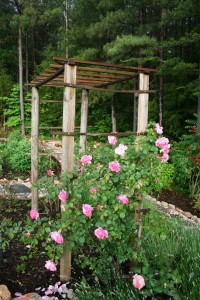My husband bought me a new Knock Out Rose. The rose garden, which I love, is also the hardest garden to care for here at Seven Oaks. Knock Out Roses promise to be the most disease resistant.
Yes, I love my roses!
But here is the sad news…except for the Blaze climber (the red one) and the light pink Sophia rose, all my hybrid tea roses died.
The pink floribunda shrub rose, “Fairy”, continues to thrive, as do the miniature roses I planted over the years. But the big roses? Black spot and Japanese beetles take their toll. I’ve had to pull out more dead roses over the years than I can count.
I was about to give up on growing roses until my friend Joan showed me her rose hedge. It was amazing. Cascades of beautiful pink roses flow down the hillside by her driveway, big, healthy bushes without a sign of black spot. I asked her if she sprayed them, since I prefer not to spray my roses and she said now – they were Knock Out roses, and did not need to be sprayed.
Knock Out roses? I’d seen the lime green pots at the garden center and was skeptical. Over the years that I worked in the garden center industry, I’ve seen my share of new rose introductions. One year it was a special hybrid tea, another a new climber….I’d always thought they were gimmicks until local friends also began swearing by the disease resistant properties of the Knock Out rose. Given the high heat and humidity in Virginia’s summers, and the propensity for mold in my garden, any plant that promises a smidgen of disease resistance gets two thumbs up fro me.
While I’ve been meaning to buy a Knock Out for some time, Hubby surprised me with the new rose bush and 23 more bags of mushroom compost for my birthday (along with some Dove ice cream bars and Friendly’s chocolate chip ice cream, my two favorite foods). Those 23 bags of mushroom compost or mushroom soil weren’t all for the rose, but we did mix in a whole bag with the new rose. I’m not taking any chances with this baby.
What should have been a five minute rose planting job ended up taking three hours when we realized that the trellis that Hubby had built for me was wobbly. We thought we could pour a little cement around the posts, but when Hubby tugged at the post the whole thing just lifted clean out of the soil, rotted through. The entire trellis had to be removed, disassembled, new posts cut, reassembled, then new holes dug and cement poured…oh my. What a day!
The final product, however, needed one final touch, even after the reassembled trellis was in place and the Knock Out rose planted. I needed to prune the lavender hedge surrounding the rose beds. Over the years, I’ve hesitated to prune lavender, and the stems grew very woody, with old dead growth and new growth going this way and that. Today, I got out the hedge trimmers, my shovel and my Felco hand pruners and went to work.
First, I hacked back all the lavender. Much to my surprise, I discovered not one but two miniature roses eaten alive by the lavender hedge. I thought they were dead. I dug them up and moved them to a new location well away from the lavender.
All of the lavender was trimmed today, along with the Fairy floribunda rose. I didn’t prune it but rather shaped it a bit, and cut out the dead growth. I also weeded a little bit and replanted five baby lavender plants to a hillside in the garden that seems to grow nothing but weeds.
Knock Out Roses Care
I’m pleased with the new rose garden and promise to take photos as soon as I see some blooms appear. For now, though, I’ll nurse my wounds. When will I ever spring for a pair of rose gloves to protect my hands? Cloth gardening gloves, my friends, do not protect you one iota from the canes of a determined floribunda rose, that’s for sure….
As for the Knock Out rose, the Cooperative Extension website tells me that my new acquisition…
- Is winter hardy to zone 5. I’ve seen some website claim to zone 4 but I’d bet zone 5 is probably accurate.
- Likes a soil pH of 6.o to 6.5
- Needs some pruning
- Will grow up to 8 feet tall if not pruned!
- May need an occasional insecticide application but does have superior black spot resistance (hurrah!)
So there you have it. My new rose is snug in her sunny rose bed, because like all roses, she needs 6 to 8 hours of sunlight each day. In the meantime, I’ll be counting the days until the first Japanese appear. Then, armed with my organic Neem oil spray, I’ll be ready to guard my new Knock Out rose from the invaders.
More information on roses on Home Garden Joy:
- How to Build a Trellis for Climbing Roses
- Types of Roses for the Home Garden
- Climbing Roses and Building a Rose Arbor
If you would like to learn more about Knock Out Roses, please see:
- The grower’s website, Star Roses and Plants
- Florida Cooperative Extension
- University of Maryland Cooperative Extension
Please visit the following websites to purchase a Knock Out Rose. I am an affiliate, and receive a little commission if you use these links to purchase products. This does not affect your price in any way.
Plants by Mail offers the hot pink double Knock Out rose. This is the one that I planted.
Professional Rose Pruning Gloves! This is what I need. Durable and covers up to your elbows, like gauntlets, for all your rose care projects.
Grow Roses without Chemicals shows you which varieties to plant and cultivation practices to grow roses without the use of harsh chemicals.









